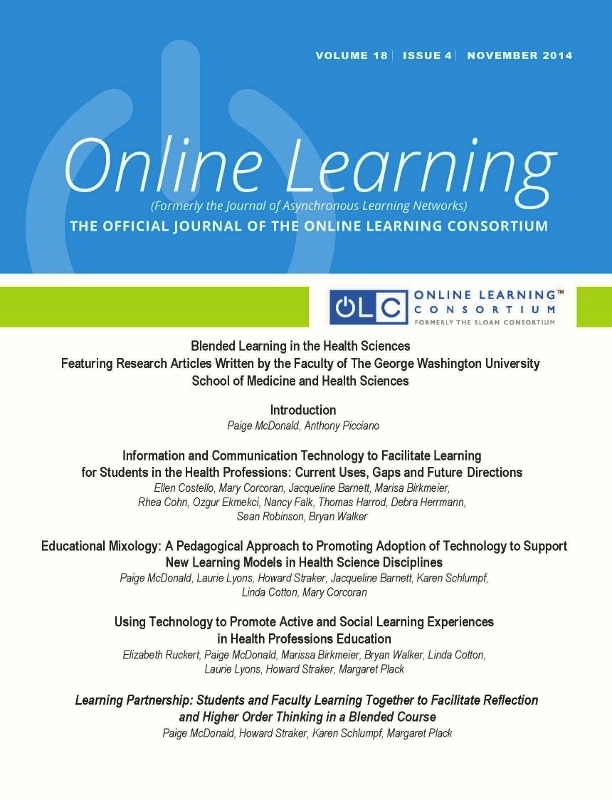Introduction
DOI:
https://doi.org/10.24059/olj.v18i4.519References
Advisory Committee on Student Financial Assistance (ACFSA) (2012). Pathways to success:
Integrating learning with life and work to increase national college completion. Report to the U. S. Congress and Secretary of Education. Retrieved from www.ed.gov
Allen, J. E., & Seaman, J. (2014). Grade change: Tracking online education in the United States, 2013. Babson Survey Research Group, Pearson and the Sloan Consortium. http://sloanconsortium.org/publications/survey/grade-change-2103
Berrett, D. (2011, September 25). Which core matters more? Differences in definitions of quality lead to new debates over the importance of teaching practical skills versus specific knowledge. The Chronicle of Higher Education. http://chronicle.com.proxygw.wrlc.org/article/In-Improving-Higher-Education/129314
Bowen, W. G., Nygren, T. I., Lack, K. A., & Chingos, M. W. (2013). Online learning in higher education. Education Next, 13(2), Retrieved from http://search.proquest.com/docview/1320281304?accountid=1124
Beckem, J. M., & Watkins, M. (2012). Bringing life to learning: Immersive experiential learning simulations for online and blended courses. Journal of Asynchronous Learning Networks, 16(5), 61-70.
Graham, C. R., Woodfield, W., Harrison, J. B. (2013). A framework for institutional adoption and implementation of blended learning in higher education. Internet and Higher Education, 18, 4-14.
Ocak, M. A. (2011). Why are faculty members not teaching blended courses? Insights from faculty members. Computers and Education, 56, 689-699. www.elseviewr.com/locate/compedu
Oreopoulos, P. & Petronijevic, U. (2013, Spring). Making college worth it: A review of the returns to higher education. The Future of Children, 23(1). http://futureofchildren.org/futureofchildren/publications/docs/23_01_03.pdf
Means, B., Toyama, Y., Murphy, R., Bakia, M., & Jones, K. (2009). Evaluation of evidence based practices in online learning: A meta-analysis and review of online learning studies.
Washington, DC: U.S. Department of Education. Retrieved December 2, 2012 from http://www2.ed.gov/rschstat/eval/tech/evidence-based-practices/finalreport.pdf
Picciano, A. G. (2007). Introduction. In A.G. Picciano & C. D. Dzuiban (Eds.), Blended
Learning Research Perspectives (pp. 5-17). Needham, MA: The Sloan Consortium.
Porter, W. W., Graham, C. R., Spring, K. A., & Welch, K. R. (2014). Blended learning in higher education: Institutional adoption and implementation. Computers & Education, 75, 185-195.
Prober, C. G., & Heath, C. (2012). Lecture halls without lectures. The New England Journal of Medicine, 366(18), 1657-1659.
Selingo, J.J. (2014). The innovative university: What college presidents think about change in
American higher education. The Chronicle of Higher Education. Retrieved from:
http://app.results.chronicle.com/e/es.aspx?s=2423&e=89593&elq=cd9973526e504845837bbada16e5b345
Taylor, P., Parker, K., Fry, R., Cohn, D., Wang, W., Velasco, G., . . . Dockterman, D. (2011). Is college worth it? College presidents, public assess value, quality and mission of higher education. Washington, D.C.: Pew Social and Demographic trends. Retrieved from http://www.pewsocialtrends.org/value-of-college/
Downloads
Published
Issue
Section
License
As a condition of publication, the author agrees to apply the Creative Commons – Attribution International 4.0 (CC-BY) License to OLJ articles. See: https://creativecommons.org/licenses/by/4.0/.
This licence allows anyone to reproduce OLJ articles at no cost and without further permission as long as they attribute the author and the journal. This permission includes printing, sharing and other forms of distribution.
Author(s) hold copyright in their work, and retain publishing rights without restrictions






